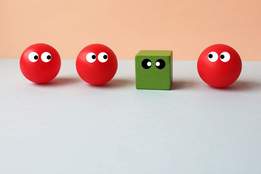You ever dance with the devil in the pale moonlight? Seems like a bad idea. Have you and a friend ever danced with the devil in the pale moonlight? Also a bad idea, but also what some might call “folie à deux.” Folie à deux refers to the presence of the same (or similar) delusional ideas in two persons closely associated with one another (living together, emotionally connected, etc.), and sometimes transmitted from one person to another. And although the term has come to recent prominence as forming the subtitle of the film Joker: Folie à Deux, its history in English dates to the late 1800s.
Folie à deux, if it is not clear from the term’s decidedly Gallic je ne sais quoi, is a borrowing from French, where it directly translates as “double madness.” Originally, its use was restricted to psychiatry:
… in folie a deux one of the patients is an active, the other a passive recipient. The active agent creates the delusions and imposes them on the other, who receives and submits easily to his influence….
— Dr. Jas. G. Kiernan, The Detroit Lancet, July 1883Freud has conceived that folie à deux is a self-identification of one of the patients with the other.
— The Journal of Philosophy, Psychology, and Scientific Methods, 1920
This clinical sense of the term is still in use, though the syndrome (or syndromes) it describes is considered rare, and sometimes known by other names.
Lasègue and Falret first described the phenomena of the transference of delusional ideas from a ‘primary’ affected individual to one or more ‘secondaries’, in close association. They coined the term ‘Folie à Deux’, a relatively rare syndrome that has long since attracted much clinical attention. Although ‘Folie à Deux’ is probably the most widely used term for this type of disorder, many other terms are used synonymously such as ‘double insanity’ and ‘psychosis of association’, leading to considerable confusion.
— Danilo Arnone, et al., Annals of General Psychiatry, 8 Aug. 2006The term folie à deux includes several syndromes in which mental symptoms, particularly paranoid delusions, are transmitted from one person to one or more other with whom the apparent instigator is in some way intimately associated, so that he, she or they also come to share the same delusional ideas.
— David Enoch et al., Uncommon Psychiatric Syndromes, 2020
Despite its relative rarity, folie à deux, like other and similar syndromes, has since its initial description found its way into both popular culture and the popular lexicon with hit-or-miss clinical accuracy, getting name-dropped in novels…
There is such a thing, I am told, as a folie à deux, a state of things where a person’s hallucination becomes so intense that he can give it to somebody else like measles and the two of them start hallucinating together.
— Frederick Buechner, Open Heart, 1972
… television shows …
It’s called a folie a deux. Two people confusing a momentary insanity for love.
— George Sibley (played by James Cromwell), Six Feet Under, 27 June 2004 (airdate)
… and other writing, where it is often used figuratively, rather than literally—even as a metaphor for love.
Uneasily, I agreed to come along and take notes. And there’s nothing more fun than folie à deux when you think you can’t be held ultimately responsible.
— Karen Odom, The Miami Herald, 26 Jan. 1983… the bewildering manner in which the White House and the contras planned and executed their continuing folie a deux.
— Peter Davis, The New York Times, 3 Jan. 1988Inviting someone to be your love object … is like inviting them into a lion’s cage. It’s asking them to lose themselves in a willed hallucination, a shared dream, a folie a deux….
—John Walsh, The Independent (London, England), 13 Feb. 2010
Though folie à deux is still not a household term, lookups for the word in our online dictionary began to spike in 2022 when director Todd Phillips posted the cover of a script bearing the title Joker: Folie à Deux to social media, leading to speculation as to what character might be involved in such a dynamic with the eponymous antihero:
That’s apparently a working title and not the official one, but it seems fair to try and read into it a bit, so let’s do that: Merriam-Webster defines ‘folie à deux’ as ‘the presence of the same or similar delusional ideas in two persons closely associated with one another.’ So… that means Harley Quinn, right?
— Sam Barsanti, AV Club, 7 Jun. 2022
Barsanti’s prediction was correct, and the film pairs Joaquin Phoenix’s Joker with Lady Gaga’s Harley Quinn. Whether the movie will push the term folie à deux into even wider common usage remains to be seen.




